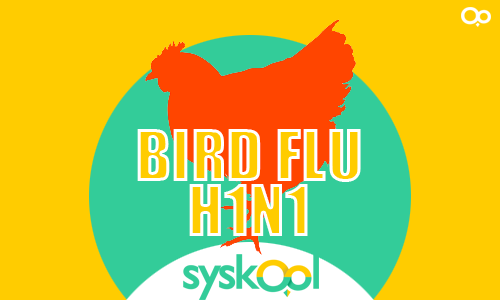Avian influenza or Bird Flu is a contagious disease of animals caused by viruses that normally infect only birds and, less commonly, pigs.
It is believed that the H5N1 is endemic to wild birds, occurring naturally in bodies of birds such as the swan, duck, and goose, surviving for long without causing them any disease. Acting as carriers, these birds which are migratory can infect other species.
The strain is believed to have spread from infected water fowl to common domestic chicken through nasal, oral, fecal and egg routes.
In domestic poultry, the infection causes two forms of the disease – low and high extremes of virulence. While the low pathogenic form causes only mild symptoms like ruffled feathers and a drop in egg production, the highly pathogenic form spreads very rapidly and kills the infected birds within 48 hours.
Symptoms and spread of
Symptoms of bird flu in humans range from the typical flu like symptoms such as fever, cough, sore throat and muscle aches to eye infections, pneumonia, respiratory diseases and other life threatening complications.
The symptoms of bird flu may depend on which virus strain caused the infection. Infected Birds shed flu virus in their saliva, nasal secretions, and faeces. Other Birds get infected when they come in contact with contaminated excretions.
Minimizing the risk to poultry
An easy to read brochure published by the UN body Food and Agricultural Organization (FAO), ‘Prevention and control of Avian flu in a small scale poultry: A guide for veterinary paraprofessionals in Cambodia’ gives simple tips that smallholders can follow to protect their flocks.
According to this guide, there are three basic principles to protecting a farm:
- Keep birds in good condition so that they are able to resist disease better. This requires good access to clean water and adequate food, adequate housing for the birds and receiving de-worming products and vaccination.
- Keep the poultry in a protected environment. Ideally, poultry should be kept in the closed building.
- Control entry to farm. People wheeled vehicle, implements, animals bought from elsewhere, and even dogs or cats carrying dead animals can bring the virus to the farm. Visitors should be kept away from where poultry leave and eat. A bucket of water and soap kept handy help reduce the risk of infection.
Bird flu and humans
Seasonal influenza affects human without doing much harm, though a very small number of old and weak persons may die of it. The common types of influenza virus in human are the A and B type. The H5N1 is a sub-type of the A virus.
It can be passed from bird to human due to close proximity. Researchers point out that several subtypes of the A virus coexist in harmony with their natural hosts (wild fowl, for instance). The viruses in these natural hosts are in evolutionary stasis that is they show minimum evolution at the amino acid level over long periods of time.
However, when they get into a new host, the viruses evolve at a fast pace. The biggest danger of transmission comes from bird droppings as these have an encrustation that provides protection to the viruses for a longer time, and chances of infection increase as the droppings dry and become pulverized.
The infected chickens die as their immune system over-reacts. The situation continues till the host develops immunity. Viruses jumping the species barrier are rare occurrences. But when it happens, as in the case of H5N1 strain, the viruses mutate to infect humans in an aggressive manner causing rapid deterioration and high fatality.
Going by the fact that, the number of human infected is low, the mortality rate is high at 50% (it is 15% in poultry), we can conclude that pathogenicity is high in humans. So far, human to human transmission of the disease is not known, but, with virus evolution and mixing of the virus and human genes, mutation enabling such transmission cannot be ruled out.
You may like reading:



